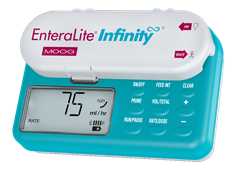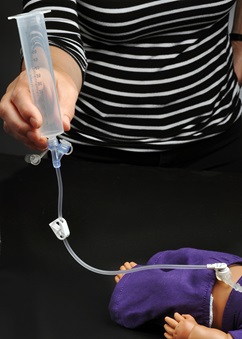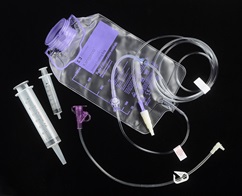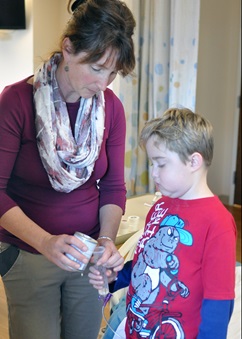In this section
Chapter 3: Feeding, flushing, and venting supplies
For more information on how to give feedings by video, visit our video page >>
Feeding your child with a tube
All children need food for health, energy, growth, and development. Food has calories, protein, carbohydrates, fat, vitamins, minerals, and water.
How much food and what kind of food your child needs will depend on:
- how old your child is
- how fast your child is growing
- your child's medical condition
The best way to be sure your child is getting the right food is to keep track of your child's growth. You should also have your child's growth and feeding plan checked at regular times. This can be done by a dietitian or doctor.
A dietitian will work with you to make a feeding plan for your child before you leave the hospital.
Other thoughts
If your child cries during the feeding, the feeding will not flow smoothly into the stomach. It is best to stop the feeding, calm your child, and then finish the feeding.
Formulas
There are many formulas or feeding choices for tube feeding. You and your child's healthcare providers will choose what is best for your child.
Examples:
- Liquid ready to feed formula
- Powdered formula
- Expressed breast milk
- Blenderized food.
Formula
Store unopened formula at room temperature.
After they are opened, cover, and keep open containers in refrigerator. Use within 24- 48 hours.
Mix powdered formula using the recipe given by your child's dietitian or doctor. Sometimes these directions might be different than what is on the formula package.
Infants under 1 year of age
For infants under a year old, expressed breast milk or infant formulas are best. They meet a baby's needs. Other liquids, thin baby foods, or liquid medicine may also be given through the tube. Only give medicines that your baby's doctor tells you to give. Your baby's doctor and dietitian will also tell you how and when to add new foods to your baby's diet.
Bonding time while tube feeding babies
Feeding time is a special time for you and your baby. If your baby did not need a tube for feeding, they would be held during the feeding. Your baby will like being held close, cuddled, rocked, and talked to during their tube feedings. Turn off the TV and put your phone aside while you are feeding your baby.
Hold your baby upright while feeding them through the tube. This is safer for your baby. Burp your baby during and after feedings.
Give your baby a pacifier to suck. Sucking exercises the jaw and satisfies a baby's need to suck. This will also teach your baby the connection between sucking and a full stomach. Sometimes infants who are fed only through the tube for a long time may forget or lose the desire to eat by mouth. Using a pacifier may help prevent this.
Toddlers, older children, and teens
Feeding is a social activity. If your child is not an infant, have them sit at the table with you so that they are with the rest of the family. When able, have your child help in giving feedings through their tube. This may be a good thing for siblings to do, too.
Feeding your child
Children enjoy being with family and friends at mealtime. Decide if it works best to tube feed your child during mealtimes with your family. There is no right or wrong way to plan the tube feeding. What is important is that you choose the method that works best for your child and your family. Turning the TV off is important for family mealtimes.
While feeding your child, keep them upright. This is safer for your child. If your child is laying down, you may need to lift the head of the bed.
Talk to your child when you are feeding them. Tell them what you are doing as you are setting up the food and connecting it to their tube.
Water and vitamins
Giving extra water
Your child must get enough fluid every day to prevent dehydration.
Watch for signs that your child is not getting enough fluids.
- Less amount of pee
- Dry mouth and lips
- Feeling dizzy
Formulas are good sources of fluid, but your child may need extra water to meet daily fluid needs. Just like you will drink something along with your meal, your child will need some extra water with their formula. This is called “extra free water.” Your child's doctor or dietitian will tell you how much extra free water your child needs. Extra water is often given after medicines, or in between or after feeds.
Vitamin and mineral supplements
Most formulas used for tube feedings have enough vitamins and minerals for infants and children. However, if you are making your own blended foods at home, extra vitamins or minerals may be needed. Your child's doctor or dietitian will help you decide what your child needs.
Oral feeding
Parents often want to know whether a child that has tube feedings can also eat food by mouth. This is different for each child. Some children need a tube because they cannot eat enough calories by mouth to grow. Often these children can also eat by mouth.
Some children cannot eat foods safely by mouth because the food may go into their lungs (airway). This is called aspiration. Children who aspirate may not be able to eat any food by mouth. Others may only be able to eat or drink small amounts of certain kinds of foods. If your child is working with a speech therapist, they will tell you whether your child can eat safely by mouth.
Oral hygiene
Even if your child does not take any food or liquid by mouth, it is important to care for your child's mouth. Mouth care can stop dry mouth, cavities, and gum problems.
Tube feedings and schedules
There are different ways to feed your child using the tube. You and your child's health team will decide what is best for your child. They will also help you find a feeding schedule that fits best into your family routine. This can change as your child's needs change.
Methods of feeding
Continuous drip feeding
Feedings are given slowly throughout the day and night. It is given by a feeding pump.


EnteraLite Infinity Pump Kangaroo Joey Pump
Feeding using a pump
A pump controls the flow of the formula from a feeding bag through the feeding tube. The pump moves the formula into the body at a set rate.
The pump can connect to a pole or fit in a backpack. Your child should be able to move around while they are being fed.
Your nurse or home care company will show you how to use the pump. You can also check the manual or go to the company's website for videos on how to use the pump.
Giving continuous or drip feedings
 Steps
Steps
- Get your supplies
– Formula or liquid food
– Feeding bag
– Feeding pump and IV pole
– Feeding extension set if your child has a button-type of tube
– Water for flushing - Wash your hands with soap and water
- Pour formula in the bag
- Prime feeding bag and tubing. This is to get the air out of the tubing.
- Attach end of primed feeding bag tubing to the feeding tube.
- Unclamp the tube
- Turn on the pump
- Give the amount of feeding at the rate that the doctor or dietitian told you.
- Give extra water if you were told to do so. Sometimes you will be told to give your child extra water at the end of the feeding. Only give this of your child's doctor or dietician told you to do so.
- Flush the tube. Use quick, short pushes to clear the tube and extension tubing.
- Clamp the tube
- Disconnect the tubing
- Rinse or wash supplies with warm soapy water
Giving bolus feedings
 Bolus feeding
Bolus feeding
Certain amounts of formula are fed at different times during the day or night. A large feeding syringe, a gravity drip bag, or a feeding pump can be used to give this feeding for about 20 to 30 minutes. This is the amount of time that most children take to eat a meal.
Steps
- Get your supplies.
– Formula or liquid food
– Feeding bag or gravity feeding system or large syringe
– Feeding pump and IV pole
– Feeding extension set if your child has a button-type tube
– Water for flushing - Wash your hands with soap and water
- Give the feeding by either a feeding bag or a syringe.
- If you are using a feeding bag, prime tubing. This helps to get the air out.
- Attach the feeding bag or syringe (remove plunger first from syringe)
- Unclamp the tube
- Pour the formula into the syringe or the bag. If using a pump, turn it on.
- After feeding is done, give extra free water if you were told to do so.
- Flush the tube. Use quick, short pushes to clear the tube.
- Clamp the tube
- Remove the syringe or feeding bag and extension set if needed.
- Rinse or wash supplies with warm soapy water.
A note about feeding by gravity
Formula flows down from a large syringe or feeding bag through the feeding tube. You can control how fast or slow the food goes into the stomach. Do this by raising or lowering the syringe. If using a bag, you can control by moving the roller clamp. Never plunge or push the formula. Always let the formula flow by gravity. This method is called bolus or gavage feeding.
Combination drip and bolus feeding
Some children get bolus feedings during the daytime and continuous drip at night.
Feeding through a GJ-tube
Feedings are given by a slow drip method to children with GJ-tubes. This helps keep the feedings from causing your child to vomit, have diarrhea, or discomfort.
Feedings will be given directly into the jejunum which is a part of the intestines.
- Always give continuous feedings with the feeding pump through the J-tube or J-port of the GJ-tube.
- Never bolus feed into the intestines through J-tube or J-port of the GJ-tube.
Flushing
It is important to flush feeding tubes after each use.
Reasons for flushing:
- Flushing helps push all the food or medicine through the tube.
- It also stops the tube from clogging. Sometimes the amount of water used to flush may be smaller or larger.
If your child is on a fluid restriction, it is okay to flush with a small amount of air through the tube. Your child's doctor or nurse will tell you how to flush. Often, the amount of water is 2 to 5 mL after feedings and medicines.
GJ-tubes
These tubes need to be flushed more often, to help prevent clogging.
- Flush the J-port with 2 to 5 mL of water every 4 hours.
- If your child has a break between feedings, flush after the feeding is done.
- It is important to flush the J-port every 4 hours, even if a feeding is still going.
- Flush the J-port after giving each medicine. Crushed pills and thick medicines can clog the tube easily. You may need to give a small flush in between each medicine.
- Flush the G-port with 2 to 5 mL of water once a day.
Venting the G-tube
 Venting lets your child's stomach get rid of extra air or food. It is known as burping through the G-tube.
Venting lets your child's stomach get rid of extra air or food. It is known as burping through the G-tube.
When should I vent?
If your child can not tolerate a feeding they may be vomiting, gagging or retching, crying or crabby, or have swollen belly.
Venting may be needed if your child is showing signs of discomfort. You can vent:
- before feeding
- during feeding
- after feeding
Steps
- Clamp the G-tube
- Put a large syringe without the plunger into the port of the G-tube. Hold the syringe up and unclamp the G-tube.
- After unclamping the G-tube you may hear air or see food or stomach juices come up in the syringe. Allow venting for 1 to 2 minutes.
- After all food and stomach juices have gone back down the G-tube, clamp the tube and remove the syringe. Sometimes the stomach juices may not go back down. You can use the plunger to gently push the stomach juices back down.
- Flush the tube with water if needed.
Do not throw away stomach contents unless you are told to do so.
If your child's stomach contents overflow, put the juices in another container. Re-feed the juices when your child is calm. These juices have important body salts called electrolytes. They may also have medicines that were given earlier.
If your child had a Fundoplication procedure done, the stomach may be a smaller size. Venting is often needed several times a day if your child had a Fundoplication procedure.
Supplies
 Supplies for feeding are available through home supply companies, known as DME. A Case Manager will help arrange for supplies in the hospital when your child gets a feeding tube placed.
Supplies for feeding are available through home supply companies, known as DME. A Case Manager will help arrange for supplies in the hospital when your child gets a feeding tube placed.
Home supply company
After your child goes home with a new feeding tube, supplies will be delivered to your home. Most insurance companies will cover basic feeding supplies.
It is helpful to keep the phone number for the home supply company. This way, when you are getting low on supplies, it is easy to call them to reorder supplies.
The home supply company can answer questions about feeding supplies and pumps.
Cleaning the supplies
It is important to keep all your supplies and equipment clean.
 Rinse all supplies with water after each use.
Rinse all supplies with water after each use.
Hand wash all supplies with hot soapy water each day. Rinse and air dry.
If the feeding supplies become sticky or look cloudy, a 3:1 water and vinegar solution (3 parts water and 1 part white vinegar) can also be used to clean the equipment.
Clean the ports every day with water and toothbrush if they are ENFit tubes. This will get rid of the buildup of formula and help keep tubing from sticking in the port.
How often to change supplies
- Use a new extension set every week.
- Change the feeding bag every day. If your supply does not give you enough bags, wash them. Use dish soap or 1 cup of water to 1 half cup of vinegar. Swish around and rinse it out.
Key points
- Tube feedings are given in different ways. It is important to know which way your child can be fed.
- Sometimes children are not comfortable during a feeding. There are different reasons why this happens. Venting can help.
- Do not over twist the syringes or tubing into the ports. Stop when you meet just a little bit of pressure. Over twisting could cause the port to crack or break.
- Clean the supplies after each use.

